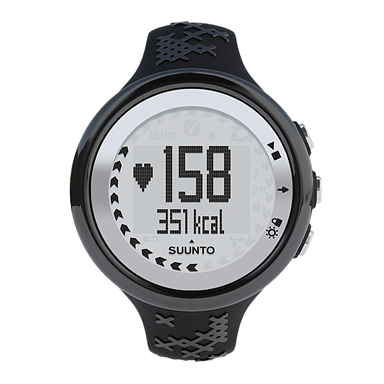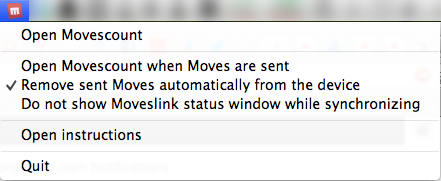Suunto M5 Review
Before I got the M5 watch for Christmas, I’d never heard of Suunto before. Despite being around for more than 75 years, they seem to be fledgling still – as suggested by the large ‘Suunto Story’ link on the front page of their website.
However, after being told by a trusted friend that they were amongst the industry leaders in sports watches, I decided to throw a fair bit of energy into the system. For the money, the product is a solid offering, as long as you’re willing to commit a bit of time to getting used to it.
In the Box
The system includes a heart rate monitor, a USB stick that’s probably very easy to lose, and the watch itself. It also comes with a confusing array of manuals, the ordering of which I’m still yet to work out. I found it much simpler to go to the product web page, and look for a manual there.
The heart rate monitor is the ‘Dual Comfort’ variety with the M5, and is ANT+ compatible: it will work with most Suunto equipment, and most likely your gym equipment too.
Core Features
The functionality of the M5 is predicated upon the ability to measure your heart rate. After entering your height, body mass, and level of current fitness (the manual details in a straightforward manner how to calculate this) when setting up the device – and thereby inferring your body mass index (BMI) – the M5 can produce an exercise regimen tailored for a goal based either in fitness, or final body mass. You can also set the watch to ‘free’ mode, meaning you just exercise when you please.
In Use
Exercise
I opted for the ‘target fitness’ goal, and went for a run around the 3.8 km track near my house. During exercise, the unit lights up multiple dots around the display, to indicate how far along you are into your workout, according to its exercise plan. While the science behind this, according to their literature, is based behind the American College of Sports Medicine, running to a schedule seems like a really boring idea, for two reasons. Firstly, you are expected to run to a heart rate, or amount of effort, that it desires. As you run, it tells you via the display whether or not to increase or decrease your heart rate. This can affect your psychology, which I find increases more than most things my performance when I go for a run. When you feel a surge of energy – maybe ‘Eye of the Tiger’ just came on shuffle in your headphones – it is at best lame, and at worst counterproductive to squander the opportunity. Secondly, the system assumes you’re on a treadmill, or have a car that follows you for the sole purpose of taking you home after you’ve run your allotted effort for the day. If you’re a treadmill kind of person, cool. You’ll love this. I just ignored the suggestions entirely, after about half way into my run, and subsequently set the mode to ‘free’, which doesn’t in any way dictate how you should exercise.
That being said, Suunto seems to have put quite a lot of effort into the method for calculating your exercise programme. It’s not just a random generator with a calendar interface; they go into a fair amount of depth, and all of it seems justified.
Despite not utilising one of the higher-end features, I felt like the watch did a good job of staying out of the way when exercising, and having enough display modes to satisfy someone like me who wants to know all of the numbers now.
Being able to lock the display certainly helped put my mind at ease, even if it probably didn’t stop anything bad from happening. The backlight was helpful, given that I was running at 1 am, but a little annoying in that the button to activate the backlight is the same as the button to say ‘no’ to menus sometimes. That is to say, the user can’t activate the backlight half-way through doing something. This is usually fine, except for when I tried to stop the timer right on the finish line. The watch beeped, indicating it had thrown up a message: “Do you really want to stop the timer?”. I pressed the backlight button, to read the message. This answered “no” to the unit, which in turn kept the timer running. Sure, my time was only out by a few seconds, but that’s still annoying.
Afterwards
Any sports logging device worth its salt will come with some ability to interface with a computer, and probably some semi-forsaken web interface so you can do something with social buzzwords that the executives and marketing people at the watch company though would really help propel the company into the next decade. The Suunto M5 is no different.
The small USB device included in the box is plugged into your computer, after you’ve installed some software called ‘Moveslink’ – this runs on your computer, even when you’re on holidays and far away from any runners – the M5 can upload all of the data that it has stored to the website Movescount. Welcome to your new training centre.
Here, your exercise events are called ‘moves’, and there’s a friendly stylised graphic for everything. It’s all a bit chintzy, but all of the information is there, and accessible in a logical way.
Thankfully, they’ve added the ability to export your moves as xlsx files.
Summary
The Suunto M5 is a solid piece of equipment. It took me a while to understand how to properly operate it to its potential, but once I’d grasped its many capabilities – and in particular, its well-founded exercise programmes – I was impressed with the capabilities in such a small, and relatively stylish, package. However, even as a watch to just count the time and how hard you’re pushing, it’s a nice little addition to the end of your arm.



